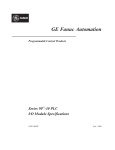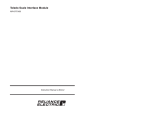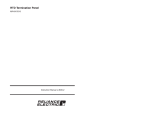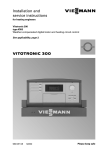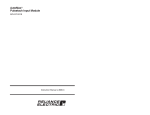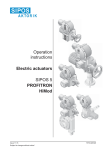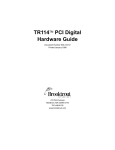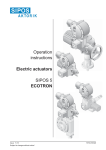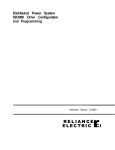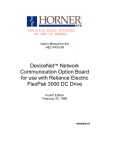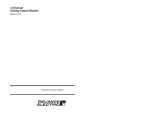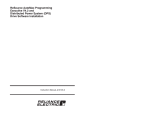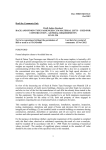Download J-3671-2 AutoMate Local I/O Head
Transcript
! ! " " "! ! #!"! ! DANGER ONLY QUALIFIED ELECTRICAL PERSONNEL FAMILIAR WITH THE CONSTRUCTION AND OPERATION OF THIS EQUIPMENT AND THE HAZARDS INVOLVED SHOULD INSTALL, ADJUST, OPERATE, AND/OR SERVICE THIS EQUIPMENT. READ AND UNDERSTAND THIS MANUAL IN ITS ENTIRETY BEFORE PROCEEDING. FAILURE TO OBSERVE THIS PRECAUTION COULD RESULT IN SEVERE BODILY INJURY OR LOSS OF LIFE. WARNING INSERTING OR REMOVING THE LOCAL I/O HEAD OR ITS CONNECTING CABLES MAY RESULT IN UNEXPECTED MACHINE MOTION OR LOSS OF CONTROL. STOP THE MACHINE OR PROCESS AND DISCONNECT POWER TO THE SYSTEM BEFORE INSERTING OR REMOVING THE HEAD OR ITS CONNECTING CABLES. FAILURE TO OBSERVE THESE PRECAUTIONS COULD RESULT IN BODILY INJURY. "!$t "t ! ! % ! && " r "!!r ! ! ! % ! && " Table of Contents 1.0 Introduction . . . . . . . . . . . . . . . . . . . . . . . . . . . . . . . . . . . . . . . . . . . . . . . 1Ć1 1.1 Additional Information . . . . . . . . . . . . . . . . . . . . . . . . . . . . . . . . . . . . 1Ć1 1.2 Related Hardware and Software . . . . . . . . . . . . . . . . . . . . . . . . . . . 1Ć2 2.0 Mechanical/Electrical Description . . . . . . . . . . . . . . . . . . . . . . . . . . . 2Ć1 3.0 Installation . . . . . . . . . . . . . . . . . . . . . . . . . . . . . . . . . . . . . . . . . . . . . . . . 3Ć1 3.1 Wiring . . . . . . . . . . . . . . . . . . . . . . . . . . . . . . . . . . . . . . . . . . . . . . . . . . 3Ć1 3.2 Installation . . . . . . . . . . . . . . . . . . . . . . . . . . . . . . . . . . . . . . . . . . . . . . 3Ć1 4.0 Configuration . . . . . . . . . . . . . . . . . . . . . . . . . . . . . . . . . . . . . . . . . . . . . . 4.1 Local I/O Head with AutoMate 20 . . . . . . . . . . . . . . . . . . . . . . . . . . 4.2 Local I/O Head with AutoMate 30, AutoMate 40, or Local I/O Processor . . . . . . . . . . . . . . . . . . . . . . . . . . . . . . . . . . . . 4.3 Local I/O Head with AutoMate Remote I/O Head . . . . . . . . . . . . . 4.4 Local I/O Head with DCS 5000/AutoMax Remote I/O Head . . . . 4Ć1 4Ć1 Diagnostics and Troubleshooting . . . . . . . . . . . . . . . . . . . . . . . . . . . . 5.1 All LEDs on the Faceplate Are Off . . . . . . . . . . . . . . . . . . . . . . . . . . 5.2 The COM LED Is Off . . . . . . . . . . . . . . . . . . . . . . . . . . . . . . . . . . . . . . 5.3 RAIL FAULT LEDs Are On . . . . . . . . . . . . . . . . . . . . . . . . . . . . . . . . . 5Ć1 5Ć1 5Ć2 5Ć2 5.0 4Ć1 4Ć3 4Ć3 I Technical Specifications M/N 61C22 . . . . . . . . . . . . . . . . . . . . . . . . . . . . . . . . . . . . . . . . . . . . . . . . . AĆ1 M/N 61C23 . . . . . . . . . . . . . . . . . . . . . . . . . . . . . . . . . . . . . . . . . . . . . . . . . AĆ2 Local I/O Head Mounting Pattern . . . . . . . . . . . . . . . . . . . . . . . . . . . . . . BĆ1 II Figure 2.1 Figure 2.2 Ć Local I/O Head (120 VAC) . . . . . . . . . . . . . . . . . . . . . . . . . . . . . . 2Ć1 Ć Local I/O Head (24/48 VDC) . . . . . . . . . . . . . . . . . . . . . . . . . . . . 2Ć2 III fafadfdfdasfdsfdsdsdfdsfdsfdsfsdfdsa afdfdsfdsfdfdsfdsfsadfda asfdfaddfdd 1.0 INTRODUCTION The products described in this instruction manual are manufactured or distributed by Reliance Electric Industrial Company. The Local I/O Head increases the number of RAIL ports available for connecting Rails and RailĆcompatible devices such as LED and TWS modules to AutoMate and DCS 5000/AutoMax systems. One AutoMate Local I/O Head allows you to connect up to 64 points of digital I/O, 16 points of analog I/O, or a combination of the two, to each of the four RAIL ports on the models listed below. Note that the various AutoMate Processor models will support different amounts of total system I/O. D AutoMate 20 Processor D AutoMate 30 Processor D AutoMate 40 Processor (M/N 45C400 or M/N 45C409) D AutoMate Local I/O Processor M/N 45C200 D AutoMate Remote I/O Head M/N 45C37, 45C38 D DCS 5000/AutoMax Remote I/O Head M/N 45C33/57C330 * * The Analog Rail modules (e.g., M/N 61C350, 61C351) cannot be used with the Local I/O Head in this configuration. This remainder of this manual describes the functions and specifications of the Local I/O Head. It also includes an overview of installation and servicing procedures. 1.1 Additional Information You should be familiar with the instruction manuals which describe your system configuration. This may include, but is not limited to, the following: D JĆ3012 AutoMate Digital I/O Rail and Modules Instruction Manual D JĆ3031 AutoMate 30 Processor Hardware Instruction Manual D JĆ3033 AutoMate Local I/O Processor Instruction Manual D JĆ3037 AutoMate Remote I/O Head Instruction Manual D JĆ3063 AutoMate Programming Executive Instruction Manual D JĆ3120 AutoMate 20 User's Manual D JĆ3140 AutoMate 40 Logic Processor Instruction Manual D JĆ3150 AutoMate 30/40 Software Instruction Manual D JĆ3630 ReSource AutoMax Programming Executive Instruction Manual D JĆ3649 DCS 5000/AutoMax Configuration Task Instruction Manual D JĆ3684 ReSource AutoMax Programming Executive Instruction Manual Version 2.0 D JĆ3750 ReSource AutoMax Programming Executive Instruction Manual Version 3.0 1Ć1 D E/M 0Ć45C33 DCS 5000/AutoMax Remote I/O Head Instruction Manual D Other instruction manuals applicable to your hardware configuration D IEEE 518 GUIDE FOR THE INSTALLATION OF ELECTRICAL EQUIPMENT TO MINIMIZE ELECTRICAL NOISE INPUTS TO CONTROLLERS M/N 61C22 or M/N 61C23 contains one Local I/O Head, one 10' Local I/O Interface cable (M/N 45C8), and two retainer clips for the cable. One Local I/O Head can connect up to four of the devices listed below (in any combination) to the AutoMate or DCS 5000/AutoMax system: D AutoMate Digital Input/Output Rail M/N 45C1ĆĆ16 points digital I/O D Analog Rail module (in AutoMate systems only) M/N 61C350, 61C351, etc.ĆĆ4 points analog I/O per rail, 16 total per Local I/O Head in the RAIL mode D LED module M/N 45C631 D Thumbwheel Switch module M/N 45C630 All of the models listed above come with an I/O Rail cable, M/N 45C5. 1Ć2 2.0 MECHANICAL/ELECTRICAL DESCRIPTION The Local I/O Heads incorporate a custom chip and an internal power supply. Model Numbers 61C22 and 61C23 are identical except for the type of power supply contained within the Head. Model Number 61C22 has a 120 VAC power supply. Model Number 61C23 has a 24/48 VDC power supply. The custom chip acts as a communication multiplexer that allows one Rail or RailĆcompatible device to communicate to each of the four RAIL ports on the faceplate. The power supply provides all of the voltages necessary to power the Head and up to four Digital Rails. A power supply is housed in a holder accessible on the faceplate. See figure 2.1 and figure 2.2. TO PROCESSOR, LOCAL I/O PROCESSOR OR REMOTE HEAD AutoMateR LOCAL HEAD 61C22 FUSE TYPE 250VAC 3AG 4 AMP L1 POWER RAIL 0 RAIL 1 INPUT RAIL 2 COM L2 GND RAIL FAULT 0 RAIL FAULT 1 RAIL 3 RAIL FAULT 2 RAIL FAULT 3 RAIL CONNECTORS Figure 2.1 Ć Local I/O Head (120 VAC) The INPUT connector is used for the Local I/O Interface cable. L1 (hot) and L2 (neutral) are input power connections. GND is used to connect a ground wire to earth ground. 2Ć1 TO PROCESSOR, LOCAL I/O PROCESSOR OR REMOTE HEAD AutoMateR LOCAL HEAD 61C23 FUSE TYPE 250VAC AGC 3 AMP +24/48 VDC COM POWER RAIL 0 RAIL 1 INPUT RAIL 2 COM RAIL FAULT 0 RAIL FAULT 1 RAIL 3 RAIL FAULT 2 RAIL FAULT 3 RAIL CONNECTORS Figure 2.2 Ć Local I/O Head (24/48 VDC) The INPUT connector is used for the Local I/O Interface cable. (+) and (-) are input power connections. GND is used to connect a ground wire to earth ground. The six LEDs on the faceplate are identical for both models. The LEDs indicate the following: 2Ć2 POWER The +5VDC supply for the Rails is within limits COM There is communication on the Local I/O Interface cable RAIL FAULT 0 The Head and Rail 0 are not communicating. An I/O reset has shut off Rail outputs. RAIL FAULT 1 The Head and Rail 1 are not communicating. An I/O reset has shut off Rail outputs. RAIL FAULT 2 The Head and Rail 2 are not communicating. An I/O reset has shut off Rail outputs. RAIL FAULT 3 The Head and Rail 3 are not communicating. An I/O reset has shut off Rail outputs. 3.0 INSTALLATION This section describes how to install the Local I/O Head. DANGER THE USER IS RESPONSIBLE FOR CONFORMING WITH THE NATIONAL ELECTRICAL CODE AND ALL OTHER APPLICABLE LOCAL CODES. WIRING PRACTICES, GROUNDING, DISCONNECTS, AND OVERĆCURRENT PROTECTION ARE OF PARTICULAR IMPORTANCE. FAILURE TO OBSERVE THIS PRECAUTION COULD RESULT IN SERIOUS BODILY INJURY OR LOSS OF LIFE. WARNING UNEXPECTED OUTPUT CHANGES MAY RESULT IF A RAIL IS PLUGGED INTO A LOCAL I/O HEAD THAT IS COMMUNICATING WITH A PROCESSOR OR REMOTE I/O HEAD. ANY HARDWARE CONFIGURATION CHANGES MUST BE MADE ONLY WITH THE LOCAL I/O INTERFACE CABLE (M/N 45C8) DISCONNECTED. FAILURE TO OBSERVE THIS PRECAUTION COULD RESULT IN BODILY INJURY. 3.1 Wiring To reduce the possibility of electrical noise interfering with the proper operation of the control system, exercise care when installing the wiring between the system and the external devices. For detailed recommendations refer to IEEE 518. 3.2 Installation Use the following procedure to install each Local I/O Head. Generally, each Head is installed directly above the Rails or RailĆcompatible devices with which it will be connected, leaving at least 2 inches of clearance between the Head and the closest device. Multiple Heads should be installed side by side, leaving at least 2 inches of clearance in between Heads. Step 1. Using the mounting pattern in Appendix B, drill four holes of approximately .218" diameter. The Head is designed to be mounted vertically using #10 bolts or studs. Step 2. Mount the Head using one of the two methods illustrated in Appendix B. Step 3. Attach a retainer clip to the connector at each end of the Local I/O Interface cable (M/N 45C8). Note that the faceplate connectors have slots that correspond to the part of the retainer clip that protrudes away from the cable connector. The retainer clip is used to ensure a tight connection between the cable and faceplate connectors. Step 4. Connect a Rail or RailĆcompatible device to one of the four RAIL ports on the Head using the I/O Rail cable (M/N 45C5) that came with the device. Continue with any remaining Rails. Instructions on mounting Rails and RailĆcompatible devices are found in the instruction manuals corresponding to the devices. 3Ć1 Step 5. Connect the Local I/O Interface cable between the Local I/O Head connector labeled INPUT and any Rail connector on the hardware with which the Head will communicate. Note that you can substitute the I/O Rail cable (M/N 45C5) for the Local I/O Interface cable (M/N 45C8) in step 5 above. You cannot, however, substitute the Local I/O Interface cable for the I/O Rail cable. If you do so, the Rail will not operate. Step 6. Verify that power was disconnected from the wires that will be used to provide power to the Head. Step 7. For M/N 61C22, connect 120 VAC and ground wiring to the terminals on the Head faceplate as follows: 120 VAC hot 120 VAC neutral ăăăăăăă- L1 L2 GND Each screw terminal can accommodate no. 12 AWG wires. Minimum wire size is 22 AWG. ąąąor For M/N 61C23, connect 24/48 VDC and ground wiring to the terminals on the Head faceplate as follows: +24/48 VDC + ăăăCommon Com ăăăăăăăEach screw terminal can accommodate no. 12 AWG wires. Minimum wire size is 22 AWG. Step 8. 3Ć2 Check the installation for proper connections, safety covers, protective devices, and means of disconnection. Verify that the equipment is ready to apply power. 4.0 CONFIGURATION Configuration is a method of describing how the system software and the I/O are related. The process of configuring the Local I/O Head is dependent upon the host. If the host is an AutoMate, use the AutoMate Programming Executive Software (M/N 45C130 or M/N 45C131) to perform the configuration. Note that the registers in which the configuration will be stored are dependent upon the register assignments of the particular model number. If the Local I/O Head will be communicating through the DCS 5000/AutoMax Remote I/O Head with a DCS 5000 or AutoMax host, use the appropriate Executive software to create the configuration that will include the registers/points accessed through the Head. Use Executive software M/N 57C300Ć57C303 for DCS 5000 Processors and M/N 57C304Ć57C307, M/N 57C390Ć57C393, or M/N 57C395Ć 57C397 for AutoMax Processors. See below for more specific information on configuring the Head. Note that if the Local I/O Head will be connected to a rail that contains a M/N 45C42 Dual Electronic Input module, that rail must be plugged into ports 1, 2, or 3 only. 4.1 Local I/O Head with AutoMate 20 Four registers are reserved for configuring the Local I/O Head for use with an AutoMate 20. These registers and the configuration value to be written for each are listed below in a sample configuration for four Local I/O Heads: 4 Local I/O Heads with AutoMate 20 4.2 Register Port# I/O Type Configuration Value Rail# or Register 2734 0 LHD 6400 0Ć3 2735 1 LHD 6404 4Ć7 2736 2 LHD 6410 10Ć13 2737 3 LHD 6414 14Ć17 Local I/O Head with AutoMate 30, AutoMate 40, or Local I/O Processor When using the Local I/O Head with the AutoMate 30 or 40, or the Local I/O Processor, only the first register of the four that are needed for the configuration needs to be specified. The Executive software automatically assigns the next three contiguous registers for the configuration. Note that even if only one port of the Head is being used, four contiguous registers are still reserved for the configuration. See below for sample configurations. 4Ć1 Sample configuration with four Rails connected to the Local I/O Head and the Master 30 or 40 Processor in slot 1: MSLT DROP TYPE RSLOT ăă1 CARD CH0 REG CH1 REG CH2 REG CH3 REG A/M 0Ć3 LHD 4Ć7 LHD 10Ć13 LHD 14Ć17 LHD Sample configuration with four Rails connected to the Local I/O Head and the Master Local I/O Processor in slot 2: MSLT DROP TYPE RSLOT ăă2 CARD CH0 REG CH1 REG CH2 REG CH3 REG LIOP 0Ć3 LHD 4Ć7 LHD 10Ć13 LHD 14Ć17 LHD Sample configuration with four Rails connected to the Local I/O Head, the Local I/O Processor in remote drop 7, slot 4, and the Master Processor in slot 3. MSLT DROP TYPE RSLOT CARD CH0 REG CH1 REG CH2 REG CH3 REG 3 ăă7 RRK ăă4 LIOP 0Ć3 LHD 4Ć7 LHD 10Ć13 LHD 14Ć17 4Ć2 LHD 4.3 Local I/O Head with AutoMate Remote I/O Head When using the Local I/O Head with the AutoMate Remote I/O Head, only the first register of the four that are needed for the configuration needs to be specified. The Executive software automatically assigns the next three contiguous registers for the configuration. Note that even if only one port of the Head is being used, four contiguous registers are still reserved for the configuration. See below for a sample configuration. Sample configuration with four Rails connected to the Local I/O Head, the AutoMate Remote I/O Head in drop 6, and the Remote I/O Processor (master) in slot 3 of the master rack. MSLT DROP TYPE 3 6 RHD 4.4 RSLOT CARD CH0 LHD REG CH1 REG CH2 REG CH3 REG 0Ć3 LHD 4Ć7 LHD 10Ć13 LHD 14Ć17 Local I/O Head with DCS 5000/AutoMax Remote I/O Head When using the Local I/O Head with the DCS 5000/AutoMax Remote I/O Head, the Local I/O Head is configured in the configuration for the rack which contains the DCS 5000/AutoMax Remote I/O master module (M/N 57C416). If you are using AutoMax Version 2.1 or earlier, see below for the format of the statement used in the configuration task. If you are using AutoMax Version 3.0 or later, the Local I/O Head is configured using the AutoMax Programming Executive. Note that you cannot mix input and output modules in Rails connected to the Local I/O Head when it is connected to a DCS 5000/AutoMax Remote I/O Head. You also cannot use the Analog Rail modules (M/N 61C350, 61C351, etc.)in this configuration. nnnnn RIODEF name[MASTER_SLOT=m, DROP=d, SLOT=s, & REGISTER=r, Bit=b] where: nnnnn Ć Configuration task line number. This number may range from 1 to 32767. name Ć Symbolic name of register or bit, ending with % (integer) for registers or @ (boolean) for bits. 4Ć3 4Ć4 mĆ Slot in rack containing DCS 5000/AutoMax master Remote I/O module. This number may range from 0 to 15. dĆ Drop number of DCS 5000/AutoMax Remote I/O Head. This number may range from 1 to 7. sĆ Communication port on the DCS 5000/AutoMax Remote I/O Head to which the Local I/O Head is connected. This number may range from 0 to 3. rĆ Register number representing the Local I/O head communication port through which the register or bit will be accessed. This number may range from 0 to 3. bĆ Optional field defining the bit position within the register number. This number may range from 0 Ć 15. 5.0 DIAGNOSTICS AND TROUBLESHOOTING DANGER THE REMAINING STEPS ARE MADE WITH POWER ON. EXERCISE EXTREME CAUTION BECAUSE HAZARDOUS VOLTAGE EXISTS. FAILURE TO OBSERVE THIS PRECAUTION COULD RESULT IN SEVERE BODILY INJURY OR LOSS OF LIFE. This section explains how to troubleshoot the Local I/O Head. Use the LEDs on the faceplate to determine the state of the Local I/O Head. If you cannot determine the problem from the instructions below as a guide, the unit is not userĆserviceable. 5.1 All LEDs on the Faceplate Are Off Problem: All LEDs on the faceplate are off. This problem indicates that the Head is not receiving 120VAC power within the specified ranges, the fuse has blown, or that the Head is malfunctioning. Step 1. Using a voltmeter, verify that the power source is 120VAC (for M/N 61C22) or 24/48 VDC (for M/N 61C23) and that it is functioning correctly. Step 2. Stop any application programs that are running and turn off power to the Local I/O Head. Step 3. Inspect the fuse. If the fuse has blown, replace it following the directions below. Otherwise, go on to step 4. CAUTION THE FUSE MUST BE REPLACED ONLY BY ANOTHER FUSE OF THE EXACT SAME TYPE, AN AGC 4AMP FUSE. FAILURE TO OBSERVE THIS PRECAUTION COULD RESULT IN DAMAGE TO OR DESTRUCTION OF THE EQUIPMENT. a) Use a screwdriver to release the fuse holder located on the faceplate. Pull the fuse holder out of the Local I/O Head. b) Take the old fuse out of the fuse holder and replace with the new fuse. c) ReĆinsert the fuse holder into the Local I/O Head. Turn the screwdriver clockwise and press down on the fuse holder at the same time. The fuse holder must be flush against the faceplate. Step 4. Disconnect the Rail cables from the Head and turn on the power to the Head. If the LEDs are lit, there is a power supply short in one of the Rails or Rail cables. Replace one item (Rail or Rail cable) at a time until the problem reĆappears. 5Ć1 5.2 The COM LED Is Off Problem: The COM LED on the faceplate is off. When lit, this LED signifies that there is communication between the Local I/O Head and the processor or Remote I/O Head to which it is connected. It should be on if communication is taking place. The possible causes of this problem are incorrect configuration, a disconnected or malfunctioning Local I/O Interface cable, a malfunctioning processor or Remote I/O Head, a rail fault, or a malfunctioning Local I/O Head. Follow the steps below to isolate the problem. 5.3 Step 1. Verify that the configuration of the Local I/O Head is correct and that no errors have been logged in the error registers. Refer to section 4.0 for more information on configuration. Refer to JĆ3120 or JĆ3150 for more information about error registers in the AutoMate 20 and AutoMate 30 or 40 processors, respectively. Step 2. Stop any application programs that are running. Step 3. If a RAIL FAULT LED on the Local I/O Head is on, troubleshoot the indicated Rail. Step 4. Examine the processor or Remote I/O Head to which the Local I/O Head is connected. If the LED indicating power is off, check the power being supplied to the unit. If power is sufficient and the LED is off, replace the processor or Remote I/O Head. Step 5. Verify that the connections on both ends of the Local I/O Interface cable are tight. Step 6. Turn off power to the Local I/O Head and the processor or Remote I/O Head. Remove the Local I/O Interface cable. Verify that there are no bent pins on the cable connectors or I/O ports. Step 7. Replace the Local I/O Interface cable. If the problem is still not corrected, replace the Local I/O Head. RAIL FAULT LEDs Are On Problem: One or all of the RAIL FAULT LEDs are on and outputs from the corresponding Rails are off. The possible causes of this problem are a disconnected or malfunctioning I/O Rail cable, a malfunctioning Rail, or a malfunctioning Local I/O Head. In DCS 5000/AutoMax systems, a rail fault of the Local I/O Head (M/N 61C22A or 61C23) will be indicated in register 4 (drop status) of the M/N 57C416 Remote I/O Communications module. For earlier versions of the Local I/O Head (61C22 or 45C22) the RAIL FAULT LEDs need to be used to diagnose rail faults as described below. 5Ć2 Step 1. Stop any application tasks that are running and turn off power to the Local I/O Head. Step 2. Try to clear the condition by disconnecting and then reĆconnecting the I/O Rail cable(s) and the Local I/O Interface cable. Make certain the connections are tight. Verify that the cables are the correct cables, i.e., M/N 45C5 between the Head and the Rails, and M/N 45C8 between the Head and the host. Step 3. Turn on power to the Local I/O Head and put the application program(s) into run. If any RAIL FAULT LEDs turn on, stop application tasks and turn off power to the Local I/O Head. Step 4. Troubleshoot the Rail(s). If the problem is still not corrected, replace the Local I/O Head. 5Ć3 fafadfdfdasfdsfdsdsdfdsfdsfdsfsdfdsa afdfdsfdsfdfdsfdsfsadfda asfdfaddfdd Appendix A Technical Specifications M/N 61C22 Ambient Conditions D Storage temperature: -20_ Ć 85_C D Operating temperature: 0_ Ć 60_C D Humidity: 5Ć90% nonĆcondensing Maximum Power Dissipation D 50 Watts with 64 I/O installed Dimensions D Height: 3.5" 8.9 cm D Width: 5.5" 14.0 cm D Depth: 6.7" 17.0 cm D Weight: 2.5 lbs 1.1 kg Electrical Characteristics D System power requirements: 120 VAC, 102 Ć 132 VAC acceptable range D Cycle loss: 3 cycles (60 Hz from low line) D Line frequency: 47.5 to 63 Hz D Transient voltages (maximum of 2 cycles): 84 Ć 138 VAC D Maximum load at 120 VAC: .5 Amps D Fuse: AGC 4Amp 250 V timeĆdelay D Output power for Rails: +5 VDC AĆ1 Appendix A (Continued) M/N 61C23 Ambient Conditions D Storage temperature: -20_ Ć 85_C D Operating temperature: 0_ Ć 60_C D Humidity: 5Ć90% nonĆcondensing Maximum Power Dissipation D 50 Watts with 64 I/O installed Dimensions D Height: 3.5" 8.9 cm D Width: 5.5" 14.0 cm D Depth: 6.7" 17.0 cm D Weight: 2.5 lbs 1.1 kg Electrical Characteristics D System power requirements: 24/48 VDC, 20Ć55 VDC acceptable range D Maximum load at 24 VDC: 6 Amps D Fuse: AGC 3Amp 250 V timeĆdelay D Output power for Rails: +5 VDC AĆ2 Appendix B Local I/O Head Mounting Pattern Appendix B (Continued) MOUNTING SURFACE LOCAL HEAD MOUNTING FLANGE .218 DIAMETER (TYPICAL) BOLT STAR WASHER TAPPED HOLE BACK PANEL LOCAL HEAD MOUNTING FLANGE NUT .218 DIAMETER (TYPICAL) STAR WASHER WELDED STUD BĆ2 fafadfdfdasfdsfdsdsdfdsfdsfdsfsdfdsa afdfdsfdsfdfdsfdsfsadfda asfdfaddfdd For additional information 1 Allen-Bradley Drive Mayfield Heights, Ohio 44124 USA Tel: (800) 241-2886 or (440) 646-3599 http://www.reliance.com/automax Publication J-3671-2 - March 1992 Copyright © 2002 Rockwell Automation, Inc. All rights reserved. Printed in U.S.A.




























